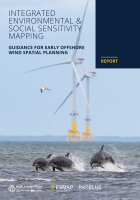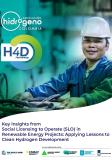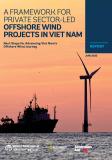Publications
While offshore wind is critical to reducing carbon emissions and helping to achieve universal energy access as envisioned by the United Nations’ Sustainable Development Goal 7, we must ensure that such turbines are installed in a way that they do not endanger marine life or harm human development. Coastal communities rely on a healthy ocean to run businesses, secure food, and prosper. Therefore, when planning and building offshore wind projects, stakeholders must consider appropriate environmental and social (E&S) sensitivities to protect biodiversity and marine and coastal ecosystem services that underpin economic activity and food security.
This guidance document, Integrated Environmental and Social Sensitivity Mapping—Guidance for Early Offshore Wind Spatial Planning (SenMap), is designed to support government planners in emerging market countries to identify potential areas for offshore wind development with the lowest E&S sensitivity. The resulting outputs—E&S sensitivity maps— can help identify broad potential development areas for offshore wind, at the earliest stages of government-led spatial planning. Sensitivity maps can support planning for avoidance, directing development away from areas where sensitivity is highest. While primarily a government-led planning tool, SenMap outputs could also be used to inform offshore wind project developers of the likely highest E&S sensitivities and enable them to select more suitable sites, plan mitigation measures, and integrate cost contingencies into competitive tenders. SenMap could also be used by developers and regulators alike to inform project-specific Environmental and Social Impact Assessment, through collating regional-scale E&S data in advance of more detailed, site-specific data collection efforts.
This guidance document is an output of the World Bank Group’s (WBG) Offshore Wind Development Program, co-led by the Energy Sector Management Assistance Program (ESMAP) of the World Bank and the International Finance Corporation (IFC). Its development and publication were made possible by funding from PROBLUE, a multi-donor trust fund administered by the World Bank that supports the sustainable and integrated development of marine and coastal resources in a healthy ocean. ESMAP’s analytical and advisory services are fully integrated within the World Bank’s country financing and policy dialogue in the energy sector. ESMAP works to accelerate the energy transition required to achieve Sustainable Development Goal 7 to ensure access to affordable, reliable, sustainable, and modern energy for all. It helps to shape WBG strategies and programs to achieve the WBG Climate Change Action Plan targets.
World Bank.
Integrated Environmental and Social Sensitivity Mapping - Guidance for Early Offshore Wind Spatial Planning (English). Washington, D.C. : World Bank Group. http://documents.worldbank.org/curated/en/099060424173523666/P1700901ab099e04a1ad5e19ad8ccceea4a




